Article
Trade Cards in 18th-Century Consumer Culture:
Circulation, and Exchange in Commercial and Collecting Spaces
Résumé
Cet article examine le mouvement de cartes commerciales au 18e siècle des consommateurs et des cultures de gestion collective. Ces annonces uniques graphiques pris en charge socio-économiques des relations pour une période limitée dans l’histoire de la consommation et est devenu prisé des produits graphiques. Je considère que la manière dont les cartes commerciales traversés publics des centres commerciaux et privés d'espaces intérieurs comme des publicités mobiles, des factures personnalisées, et les œuvres miniatures provenant de nouvelles significations et les utilisations comme ils passaient à travers l’espace et le temps. Le document complique la catégorisation traditionnelle des cartes commerciales comme “éphémères”. Il suggère que les cartes commerciales, plutôt que de fonctionner comme des fragments de la culture jetables promotionnel, diffusés au sein de la société commerciale et la collecte de cercles en tant que valeur des jetons de privés échanges économiques et que les objets raréfiés.
Abstract
This paper examines the movement of trade cards in 18th-century consumer and collecting cultures. These unique graphic advertisements supported socio-economic relationships for a limited period in the history of consumption and became sought-after graphic commodities. I consider the ways in which trade cards traversed public commercial centres and private domestic spaces as mobile advertisements, personalized bills, and miniature artworks accruing new meanings and uses as they passed through space and time. The paper complicates the traditional categorization of trade cards as “ephemera.” It suggests that trade cards, rather than functioning as throwaway fragments of promotional culture, circulated within commercial society and collecting circles as valued tokens of private economic exchanges and rarefied objects.
1 In the 18th century, a variety of printed promotional formats disseminated commercial knowledge across local, national, and global contexts to expanding networks of buyers and sellers. Print technologies enabled diverse forms of printed advertising to be reproduced multiple times. Commercial advertising was not restricted to newspapers. Tradespeople promoted their products and services using a variety of printed formats from ephemeral handbills advertising temporary sales to high quality catalogues, billheads, and trade cards produced to survive prolonged use and multiple exchanges. These marketing devices conveyed messages about the nature and status of businesses while offering basic information on the everyday activities of buying and selling.
2 Not all commercial advertisements were simply vehicles for communicating informative advertising copy to consumers. Using examples of British, French, and American trade cards, this article examines the changing role and significance of these unique advertisements as they moved between people and spaces of varying scales in commercial knowledge transfers and collecting cultures.1 Trade cards were not specific to one particular geographic domain or trade. They were used in different countries by a wide variety of tradesmen with a wide range of products to promote and sell. They moved between people and places not only as transmitters of information but also as adaptive objects deeply connected to the vagaries of commercial activity and economic exchanges underpinned by distinct socio-cultural expectations.
3 Different forms of movement had an impact on the manner in which trade cards were used and adapted throughout their lifecycle. They accrued new meanings and uses as they moved between diverse cultural contexts for a variety of purposes. Trade cards disseminated at local, regional, national, and international levels possessed a mnemonic value connected to both the lived and the virtual experiences of consumption. Trade cards moving back and forth between economic agents as invoices and receipts in systems of credit became gifts of thanks that hinted at the mutual obligations of transactions based on trust. Across the extended lifecycle of trade cards, some examples moved from commercial centres to collecting environments, where their business uses were reconfigured as they became subsumed into private print collections. Through these various modes of exchange and retention, trade cards circulated as culturally transformative objects, developing meanings according to personal use and appropriation that transformed their status from commercial advertisements to mobile mediatory devices and print collectibles.
Background and Context
4 Trade cards were single-sheet advertisements freely distributed to provide consumers with information on the nature and location of individual businesses. Some of the earliest examples can be found in France in the early 17th century.2 In England, “shop bills” or “shopkeepers’ bills” began to appear in the mid-17th century and, in America, in the 1720s.3 They existed well into the 19th century and can be considered a precursor to the modern-day business card. However, it was in the 18th century that they circulated as multi-purpose advertisements, unique invoices, and referential graphic prints before lithographic printing techniques revolutionized advertising opportunities and rates of production.
5 While trade cards can be seen as part of a wider group of printed business ephemera, they were unique in both form and function. In contrast to advertisements seeking to persuade an anonymous public to consume particular goods and services, trade cards were freely distributed among a known or anticipated customer base to remind shoppers of a tradesman’s location and merchandise. Furthermore, the size and adaptability of trade cards facilitated direct exchanges between people. Throughout the 17th and 18th centuries, they ranged from a few inches to large folio sheets, which were folded to assist portability. Trade cards were also visually distinctive, functioning as multimedia prints that combined text and image to convey and reinforce the marketing message.
6 This coupling of the visual and verbal resulted from a particular production process. Trade cards usually exhibit indented plate marks around the central image and fine lines of dried black ink. These markings identify them as engravings produced from metal plates, a medium that easily accommodated text and image. This form of print production depended upon a division of labour involving a draughtsman, an engraver, a printer, and occasionally a calligrapher. As a result, trade cards, prior to circulating within commercial environments, had moved between several hands and production spaces. After an engraver had cut the design into a metal plate, a skilled printer ran the inked plate and a sheet of paper through a rolling press. Individual sheets were hung to dry and then periodically checked to review the quality and accuracy of the reproduction. This time-consuming process of production limited print runs to batches of one hundred copies or less, elevating trade cards to the status of graphic prints intended for distribution to privileged consumers.
7 The tradespeople who invested in this form of advertising usually owned businesses connected to the luxury and semi-luxury trades or services associated with enhanced living standards, hygiene, and comfort. Many trade cards publicized the unique wares of craftsmen, artists, inventors, or specialist suppliers. They helped fashion commercial identities around concepts of luxury, novelty, and usefulness by promoting the desirability of particular products and the lifestyles that framed them. In France, despite a buoyant market for second-hand goods, trade cards rarely promoted used wares, indicating the role they played in marketing consumer goods in the newest taste.4 Later in the century, trade cards began to advertise businesses associated with leisure, tourism, and finances such as hotels, galleries, libraries, and insurance companies. By the late 18th century, the range of businesses and specialist trades advertised via trade cards reflected the development of early capitalist economies and all the facets of commerce, industry, and leisure that these consumer societies generated.
8 In early commercial cultures on both sides of the Atlantic, tradespeople utilized the power of print to circulate business information and establish professional identities. While this article focuses on examples from Britain, France, and America, trade cards were not unique to these places. They were also used in a number of European countries including Italy, Germany, Austria, and Holland. It is probable that they were also adopted in 18th-century Canada. Canadian tradespeople, like their American and European counterparts, commissioned advertisements from engravers and printers. The records for a print shop operating in 18th-century Québec reveal that tradespeople used single-sheet advertising ephemera to promote their businesses. In 1779, when the Brown/Neilson firm supplemented its letterpress with a copperplate printing press, it began receiving orders for all sorts of advertisements produced from “copper plates,” including “hatt bills,” “labels,” and “cards with advertisement upon them” (Fleming and Alston 1999: 419, 495-96). While Fleming and Alston observe that only “a fraction of single leaf imprints has survived” from 18th-century Canada (xviii), the records for this particular print shop suggest that tradespeople in the city of Quebec depended upon high quality printed advertising to promote their businesses. It is likely that this also occurred in other Canadian towns and cities, a pattern replicated in Britain, America, and France.
9 The material and visual attributes of trade cards adapted over time as new materials and engraving methods became available. In the 18th century, etching techniques originating from France enabled engravers to produce intricate and complicated designs more easily. Michael Snodin credits the technique with the rapid increase of trade card production in England between the 1740s and 1770s, when elaborate rococo styles dominated designs (1986: 84). This style was also adopted in America where trade cards began to feature ornate frameworks reminiscent of their English counterparts. The card for Philadelphian coppersmith Benjamin Harbeson (ca. 1760), adapted from the English card for razor-maker Henry Patten, depicted a variety of merchandise hanging from elaborate scrollwork (Fig. 1). Henry Dawkins, the English engraver of Harbeson’s card, immigrated to America and began working in Philadelphia from the late 1750s (Jay 1987: 9). It is probable that English trade cards and other graphic prints were transported to America with immigrant craftsmen like Dawkins. The visual presentation of knowledge and information using decorative cartouches and pictorial vignettes became popular across numerous print genres in England and America, and trade cards began to resemble a wide variety of other single-sheet engravings and images found in illustrated books and journals.
10 The highly graphic content of trade cards was not merely decorative; it also served to convey multi-layered messages about the status of the tradespeople and their customers. The suggestive interfacing of word and image offered consumers what Natacha Coquery has described as “double seduction” (2004: 74). The text on trade cards was generally limited in order to succinctly relay promotional messages. Instead of providing shoppers with a full inventory of a tradesman’s stock, trade cards gave a general impression of the range as a way of igniting curiosity in consumers. Specific linguistic phrases such as “all sorts of ” and “a great variety of ” were used repeatedly across trade cards in Britain, France, and America. The card for French confectioner Géry Dupont (ca.1770-1790) tantalizingly displayed edible goods on a large table alongside text describing “Chocolats de toutes especes [sic],” “Sirop de toute qualité,” et “des Glaces de touts gouts” (all types of chocolate, many kinds of syrup, and ice cream for all tastes; Fig. 2). These succinct summaries were employed to provoke fascination for Dupont’s produce and a return to the shop to explore his full range.
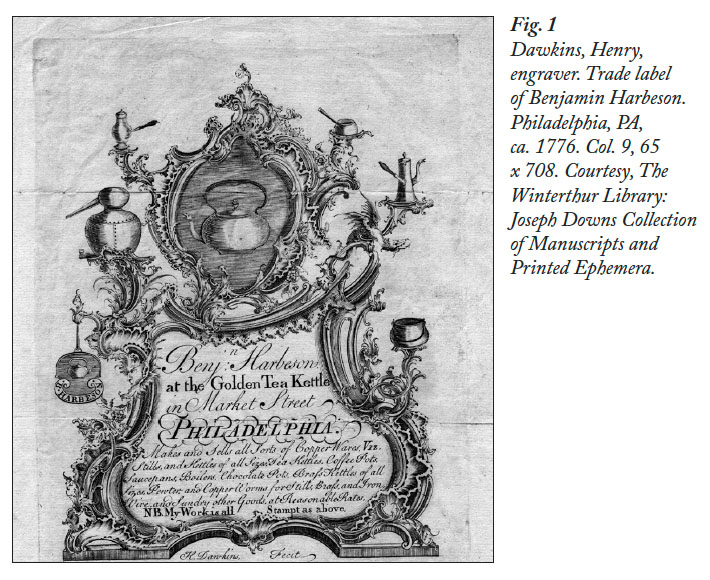 Display large image of Figure 1
Display large image of Figure 1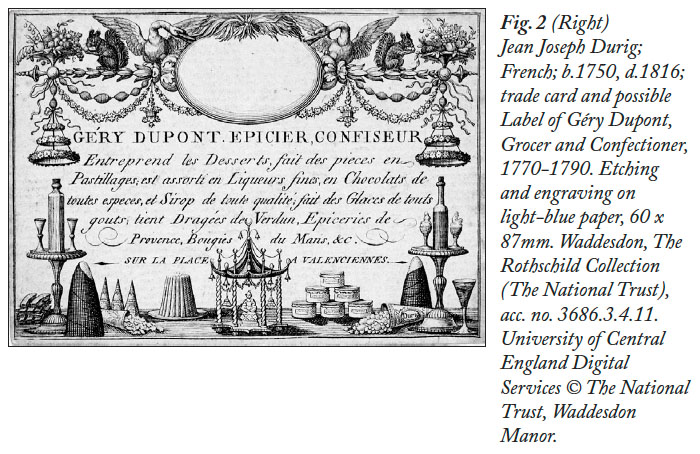 Display large image of Figure 2
Display large image of Figure 2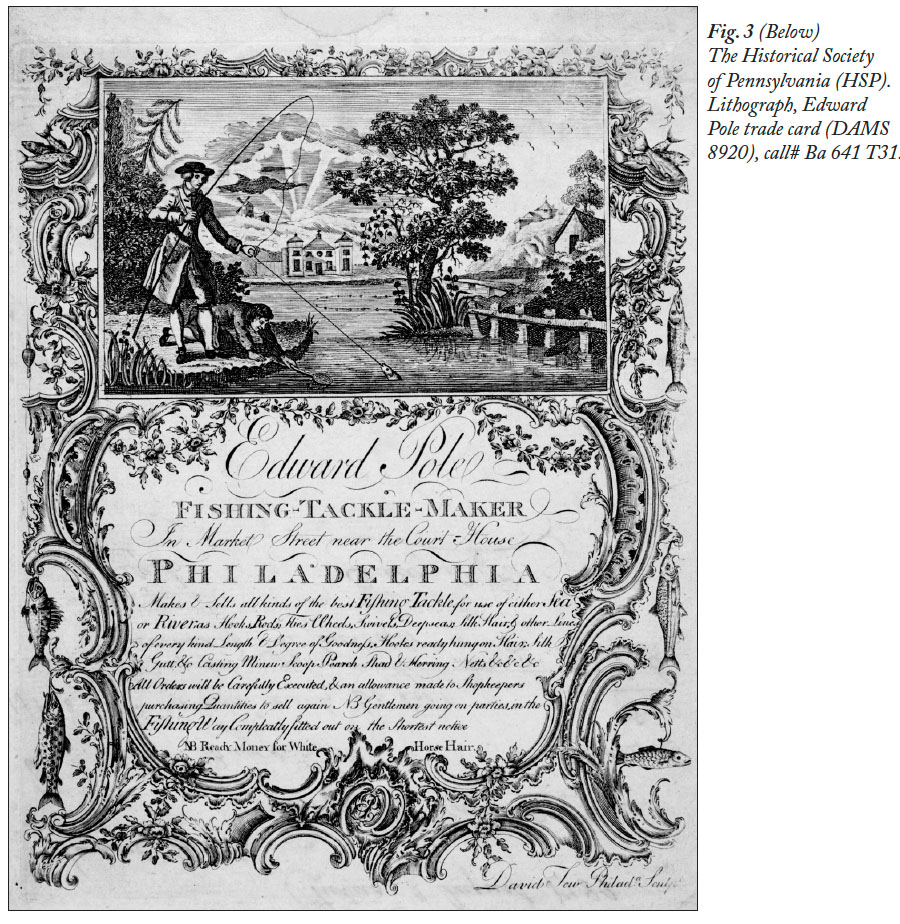 Display large image of Figure 3
Display large image of Figure 311 Evocative visual imagery accompanied distinctive textual phrases on trade cards. Miniature reproductions of consumer goods, images of shop interiors, and visual depictions of store windows produced iconographical allusions connected to the experiences of purchasing, owning, and displaying commodities. Phillippa Plock has noted that French trade cards added to the “visual world of temptation” associated with shopping in the 18th century (2008: 22). While primarily visual in their functioning, the images on trade cards also invoke other sensory fields linked to the oratory, olfactory, and tactile dimensions of shopping. By exploiting all sensory domains, trade cards connected consumers, bodily and imaginatively, to acts of consumption.
12 The visual celebration of consumption on trade cards stood in sharp contrast to other forms of commercial advertising in the 18th century. In particular, newspaper advertising lacked visual appeal. Advertisements in American newspapers generally offered readers more illustrated material than their French and British counterparts, but this still remained limited in comparison to graphically sophisticated trade cards. The card for Edward Pole (ca. 1775), a fishing tackle maker based in Philadelphia, included elaborate decoration and a detailed pictorial scene depicting a smartly dressed gentleman enjoying the activity of fishing with Pole’s “best” products (HSP, Advertisement for Edward Pole 1784; Fig. 3). The ornate rococo border not only frames the central advertising text but also elevates the status of the activity and its associated paraphernalia. The dense, exuberant border punctuated with images of fish projects the idea of plenty and the positive results delivered to “gentlemen” upon using Pole’s fishing equipment. In contrast, his largely text-based newspaper advertisement included the single image of a fish set within a simple typeset border (Fig. 4). Although both promotional genres offered consumers information, Pole’s newspaper advertisement relied upon prosaic text while his trade card conveyed the marketing message through a skilful combination of text and image.
Historiography and Methodology
13 Until recently, trade cards suffered scholarly neglect and were perhaps viewed as objects tied to the collections of individual enthusiasts and earlier histories lacking critical scrutiny. 5 Trade cards also pose distinct challenges for researchers. There is little historical documentation connected to trade cards, and it is difficult to categorize a print genre that is neither purely promotional nor a graphic commodity produced for sale. Furthermore, while trade cards have been treated as a subset of the wider category of “ephemera” as “fragmentary documents of everyday life” (Rickards 1988, 2000), they often held long-term appeal as both practical business documents and print collectibles, a paradox that further complicates their categorization as a historical source.
14 However, with the rise of scholarship related to consumer culture, trade cards have become serious historical sources by providing illustrative evidence for the emergent commercialization of 18th-century society. Other studies have focused on the unique form and functions of trade cards as well as their wider cultural significance (Berg and Clifford 2007; Coquery 2000, 2004; Hubbard 2009; Kim 2002; Scott 2004). The fields of material and visual culture studies have partly influenced this shift in the appreciation of trade cards by providing the intellectual impetus to interrogate sources beyond more traditional texts and images. In particular, research into aspects of material culture has been especially important in focusing attention on the minutiae of everyday life and the seemingly inconsequential objects, activities, and habits that impact wider cultural processes and social practices (Herman 1992; Martin 1999; Ulrich 2001). For the study of trade cards, this academic focus on the habitual and demotic is crucial in helping to re-evaluate a genre that traditionally has had its sociocultural significance bypassed through an association with more general categories of ephemera.
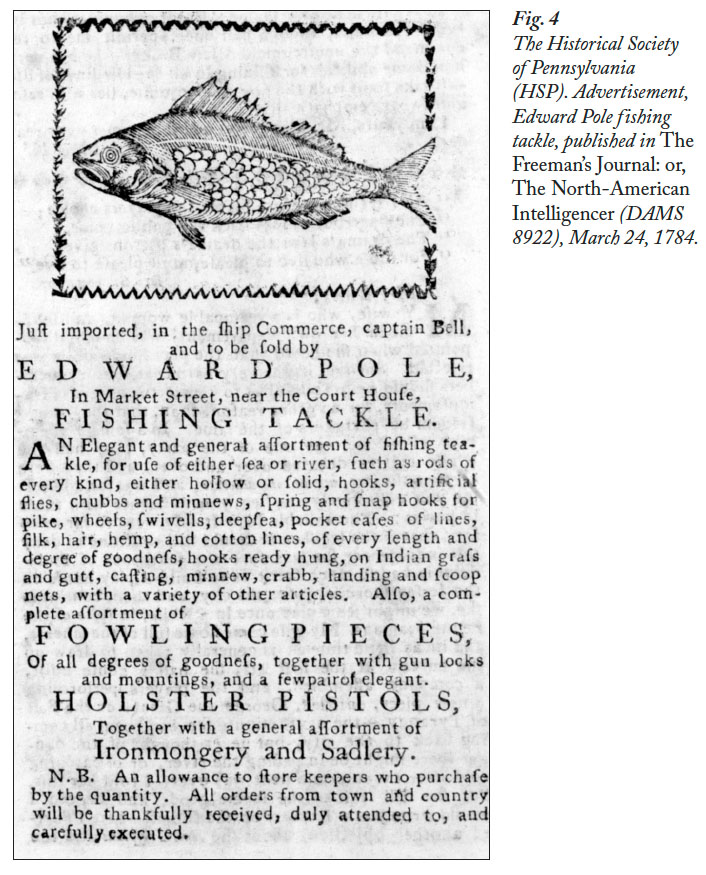 Display large image of Figure 4
Display large image of Figure 415 Material culture studies have also equipped us with the methodological tools to interrogate unusual sources. For objects such as trade cards, with very little documentary evidence of their past, material and visual attributes are central in helping to answer questions about function, circulation, and lifecycle. Trade cards enclose their own archaeologies of use, which can be unpacked by engaging with the materiality of the object. Trade cards as single, portable objects can be held in the hand and studied close to the eye. The texture of the paper can be felt, the size and shape of the item more easily ascertained, and signs of human interaction more clearly identified and interpreted. While a textual reading of an advertisement can suggest information about consumer preoccupations, fashions, and tastes, it can rarely reveal how advertisements were exchanged and retained within public and private spaces. Moreover, items of ephemera rarely present themselves as pristine artifacts. Instead they are usually “damaged” objects that have been folded, torn, and annotated. These markings are sites of knowledge offering interpretative clues about the lifecycle of an object, the functions it performed, and its wider socio-cultural significance. By studying the materiality of these artifacts, we come to understand how their material markings are purveyors of human interaction as they moved between multiple people and spaces in the past.
16 The contexts in which trade cards existed in the past and survive in the present reveal further clues about their meanings and uses, which mutated as these objects moved through space and time. Bernard L. Herman has stressed the importance of reconnecting objects to their historical context (1992: 7). He observes the “instabilities of meaning,” suggesting that “what things meant depended on the perceptions of audience and actors in shared and infinitely mutable contexts” (2006: 57). The movement of trade cards was connected to complex choreographies of distribution and exchange through which meanings were produced and reconfigured as they moved between the contexts of commercial spaces and collecting environments.
Trade Cards: Movement, Meaning, and Memory
17 In the 18th century, the idea of shopping as a leisure activity became firmly rooted in the public imagination. During this period, shopping suggested the pleasures of perusal and decisionmaking in acts of buying rather than the prosaic acquisition of necessities.6 Trade cards embodied the spectacle of consumption and the anticipation of future shopping experiences. They functioned as an aide mémoire to reinforce existing economic relationships and the memory of particular acts of buying (Scott 2004: 96). They were designed and adapted for distribution at local, regional, national, and international levels. As they passed from commercial spaces to domestic settings, they were re-appropriated as mementos around which behaviours, expectations, and memories associated with private acts of consumption were formed.
18 Trade cards disseminated at a local level were handed to prospective customers within retail spaces or included with packaged goods at the point of transaction. By distributing trade cards within shop spaces, tradespeople forged a direct line of communication with individual shoppers. Surviving examples with larger dimensions often exhibit prominent score lines, marking where they were folded to increase portability as they were passed from retailers to selected customers. Lisa Forman Cody has suggested that the more disreputable suppliers, such as quack doctors, exploited the anonymity of newspaper advertisements, capitalizing on buyers “not wanting to have face-to-face encounters” (1999: 110). In contrast, the direct movement of trade cards from one person to another precluded anonymity as buyer and seller made a connection that facilitated verbal contact and perhaps the exchange of pleasantries, observations, and opinions.
19 For the customer, this encounter produced a memory connected to a particular shopping experience. The evocation of this memory away from the shop was often site-specific, connected to a local urban space and specific retail environment. For the earliest British, French, and American trade cards this association with space was produced through visual references to shop signs, providing an indication of a store’s location and sometimes the goods and services sold there. Images of shop signs often were the central visual component of the earliest trade cards. In later examples, the signs became subsumed into wider ornamental designs, relaying more complex messages about a tradesperson’s credentials. Despite changes in trade card designs over the 18th century, place and space remained central promotional themes. From the late 1760s, when shop signs were largely absent from the streets of London and Paris and numbering was introduced, trade cards often provided an address or a textual description of the shop’s exact position within a local environment.
20 Other trade cards offered a visual representation of the shop facade or interior space as a visual cue to the store’s location and as a reminder of the pleasurable acts of shopping performed there. The card for Abraham Price (ca. 1710) focused attention on Price’s shop within the urban space, reiterating the memory of the store in a more experiential way than simply associating it with a particular shop sign or an address (Fig. 5). While Price’s card perhaps offered viewers a fantastical imagining of his shop, it provided real verbal and visual information about its location and what it had to offer. While the open doorway at the centre of the image serves to lead viewers into the store, it also demarcates the space between the shop and the street occupied by shoppers and two itinerant sellers hawking their wares. Price’s luxury warehouse filled with extravagant wallpapers in various colours, designs, and textures is juxtaposed against the figures of the street sellers whose merchandise hangs inelegantly about their person. By contrasting the bawdiness and slovenliness of the street with the civility and comfort of Price’s shop, the trade card highlighted the opposing sites of consumption and the discrepancy in the cultural and material pleasure each offered.
21 Shopping at Price’s store not only evoked the visual pleasures of consumption but also hinted at the other sensory spectacles connected to lived experiences and memories of shopping—the tactility of the wallpapers on display and the sounds of the productive workshop, just audible from the quiet calm of the shop interior. While Price’s store was part of a specific urban space, it was also distinct from it, offering consumers a novel and pleasurable shopping experience. The card also served to remind shoppers of Price, the centrally located figure who stands proud as both a “maker” and “seller” of paper wall hangings. Price’s demeanour and animated behaviour, docking his hat in a gesture of deference to the elegant passers-by, provide a striking contrast to the open-mouthed street sellers and serve to highlight his role as the proprietor of this luxury emporium.
22 The memory of the shopkeeper and his store was perhaps enhanced by the physical act of passing a trade card to a customer. The proximity of the trade card to self, through handto-hand contact, established and reinforced the relationship between buyer and seller. Sensory engagement with the object as it passed from person to person highlighted this association and the memory of a particular commercial exchange. The materiality of a trade card was paramount to a customer’s perception and memory of a shopkeeper and his wares. Trade cards were advertisements designed to look and feel special. As David Howes has observed, “sensing (seeing, hearing, touching etc.) [is] primary and meaning [is] mediated” (2006: 163). To fully understand a material object, one must experience the “feel, the weight, the smell, the sound” (169). Trade cards produced from clean, high quality paper made a statement not only about the shopkeeper but also about the status of the customers and the high esteem in which they were held. The singularity of trade cards and the mode of their exchange within intimate retail spaces elevated the role touch played in recalling the experience of consumption.
23 Tradespeople also distributed trade cards to customers at regional and national levels, where physical distance precluded direct contact. Trade cards were sent to customers’ homes as a way of transferring commercial knowledge across geographic space. Surviving examples in personal correspondence and household accounts suggest the various ways in which they sustained commercial exchanges beyond retail spaces. Trade cards supported socio-economic relationships over time and distance by facilitating the ordering of goods while connecting consumers vicariously to acts of shopping.
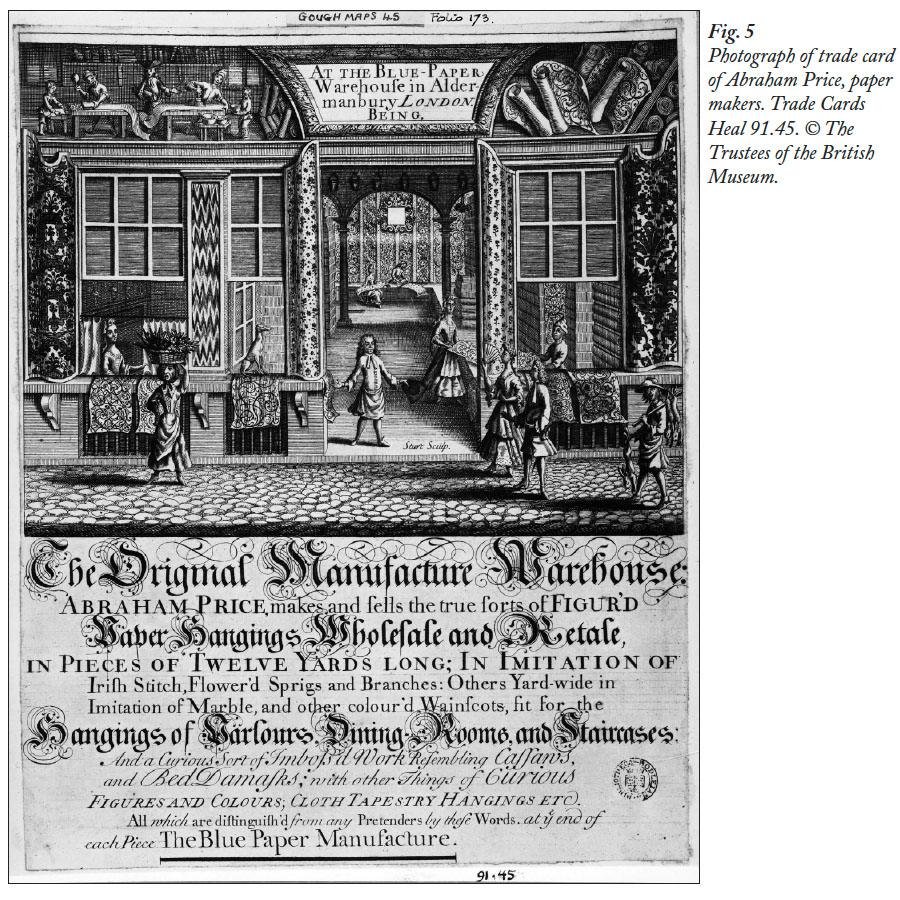 Display large image of Figure 5
Display large image of Figure 524 In the 18th and 19th centuries, wealthy Scottish families frequently purchased consumer goods from London suppliers for their residences in the capital or their homes in Scotland. The trade cards of London tradespeople that made their way into Scottish households provoked consumers there to recall particular shopping experiences and helped guide customer choices while away from commercial centres. The printed catalogue and trade card for London-based seedsman and florist John Cormack, surviving in the Ogilvy family papers, served to remind the family of Cormack’s particular wares and perhaps helped direct the choices it made hundreds of miles away from the point of distribution (NAS POF, GD248/361/4/31-2). At the turn of the 19th century, a private letter received by Sir James Grant in Scotland responded to an enquiry into “the seats and machinery for a water closet.” The letter included a trade card for a “patent engine, lock and water-closet manufactory” endorsed on the reverse with prices for Grant to study (NAS POF, GD248/702/3/2). These trade cards permitted customers away from commercial centres the experience of shopping and tied their virtual acts of consumption to a specific tradesman and a particular store.
25 The connections between trade cards, specific products, and memories of consumption are especially pertinent where they circulated directly with consumer goods as wrappings and forms of identification. Surviving objects from the 18th century, such as pieces of furniture, musical instruments, and boxes, reveal that trade cards were occasionally adhered to consumer goods. In 1798, Superfine Colour Manufacturer, Reeves and Son, placed an advertisement in The Times newspaperwarning buyers of counterfeit products on the market. They noted that “every Box of their genuine Colours have written in their own hand-writing ‘Thomas Reeves and Son’ on their shop-bill, or copy of the Letter from the Society of Arts, which is pasted in every Box from their Shop” (TDA, Advertisement for Reeves and Son 1798). Trade cards adapted in this way formally identified the makers of specific products and served as an aide mémoire for where the object and similar other articles could be purchased. These advertisements then became part of an object’s materiality, travelling with the object as it moved between different people and contexts throughout its lifecycle.
26 Trade cards also moved internationally to support economic transactions. For Joshua Johnson, an American merchant who temporarily relocated to London in order to forge new business connections, trade cards provided an essential form of recollection. During his residence in London in the 1770s, Johnson sent his American partners London trade cards with samples of stock. Johnson requested that they “make [their] remarks on each tradesman’s bills; it [would] govern [him] for the future” (Price 1979: 39-40). 7 In a later letter, Johnson responded to his partners’ opinions: “In consequence of the complaint against the silks, I have returned to Crosier ( John Crozier) [though] I don’t think him so cheap as Spenloves (Francis Spenlove)” (82-86). The trade cards for both mercers had presumably passed from Johnson to his partners who had used them to record and communicate their opinions back to Johnson. The text on these trade cards appealed directly to merchants. Crozier supplied silks for “Merchants and Country Shopkeepers ... on ye most Reasonable Terms,” while Spenlove sold “Wholesale, Retail and for Exportation.”8 As portable advertisements, these trade cards moved between people and places in knowledge transfers that circulated commercial information to expanding networks of buyers and sellers across vast geographic space.
27 Trade cards also crossed international boundaries as material tokens of travel. In the 18th century, souvenirs from new places or foreign countries became private possessions encoded with immense personal value and memories. Claire Walsh, in her work on shopping and tourism, identifies a new kind of shopper, “le touriste acheteur international,” which emerged during the 18th century when London and Paris became fashionable tourist centres (2000: 223). Walsh observes that the aim of the 18th-century tourist-shopper was to arrive home with objects typical of a region or place, or with examples of the finest merchandise in Europe (231). The household accounts for the Ogilvy family in Scotland include an impressive trade card for a famous Parisian toy seller, Vaugeois, from whom the Earl of Findlater had bought goods in 1783 (NAS POF, GD248/590/3/1/33). The elaborate card, endorsed with a bill, reminded the family of their expenditure and evoked the memory and emotion of shopping in a luxury Parisian store.
28 Trade cards retained within domestic spaces as souvenirs functioned as physical objects through which consumers recalled and reflected upon activities connected to consumption and travel. In the late 18th century, a lady travelling between Norwich and Edinburgh preserved her trade card from the “Tontine Inn,” where she had dined during her stay in Sheffield (NRO, BOL4/12,741X5). The card, nestled between the pages of her diary, functioned as a private token of a personal experience. Susan Stewart observes that souvenirs work by distinguishing events and activities that are not always “repeatable experiences” (1993: 135). In particular, she stresses the role that miniature objects play in mediating experience and evoking nostalgia. Trade cards traversed commercial centres and domestic spaces, becoming personal possessions that embodied private experiences and the memories used to recall them.
Trade Cards: Circulation and Credit
29 The re-appropriation of trade cards as personal possessions within domestic spaces played a central role in the recovery of debts in the 18th century. Tradespeople frequently adapted their trade cards to record the invoices of individual consumers. These personalized bills were sent to customer homes or exchanged within retail spaces to remind customers when a payment was due. Buying in the 18th century rarely consisted of the simple anonymous exchange of goods for money. Consumers usually acquired goods on credit, the terms of which depended upon the good relationship between retailers and their customers. This socioeconomic reality of retailing was reflected in the lack of printed prices on trade cards, a withholding of specific commercial information that provoked a dialogue between buyer and seller. In the French context, Natacha Coquery has noted that “purchasing an item required debate and bargaining between salesperson and customer” (2000: 103). The negotiation of prices and terms of credit formed part of the thrill and theatre of shopping. French trade cards promoted negotiable prices using terms such as juste prix and à prix raisonnable, while English and American cards deployed the equivalent terms: “reasonable rates” and “lowest prices.” These phrases indicated both fair and negotiable prices and hinted at the differential credit agreements extended by tradespeople to their customers.
30 The efficient recovery of debt was an economic imperative for tradespeople both to survive and to maintain their own good reputation and creditworthy status. In a commercial marketplace where credit facilitated both buying and selling, tradesmen and their customers relied upon receiving credit that was extended as a privilege to those who paid their debts on time. The frequency of marginalia on trade cards portrays the regularity with which they were used as bills and receipts in operations of credit. By endorsing luxury advertising trade cards with billing information, tradesmen could politely raise the matter of debt while issuing a pertinent reminder to whom it was owed. While advertising rarely leaves traces of the people for whom it is intended, trade cards adapted as invoices often include the names of buyers, the goods they bought, the prices they paid, and the date on which the bill was settled.
31 Invoices recorded on British, French, and American trade cards were organized in a similar fashion, usually on the reverse of the card with the name of the customer and date written at the top of the document and the corresponding purchases and prices inscribed below. The card for London watchmaker Thomas Hemings from 1747 shows the standard format by which tradespeople manually adapted their trade cards by recording billing information onto the blank reverse of the printed image (Fig. 6a-b). In the bill to his customer, Hemings included the date, details of the purchases made, and final amount. The invoice was sent to the debtor exactly one month after the initial transaction had been made and payment promptly followed the next day. Hemings then updated the bill accordingly, inscribing his signature at the bottom alongside an additional note that read: “received the full contents of this bill and all demands.” The trade card then functioned as a receipt, providing evidence for both parties that the account had been settled. By adapting trade cards in this way, tradesmen could efficiently communicate private transactional information while prompting consumers to recall the location of their store and the other tantalizing goods it stocked.
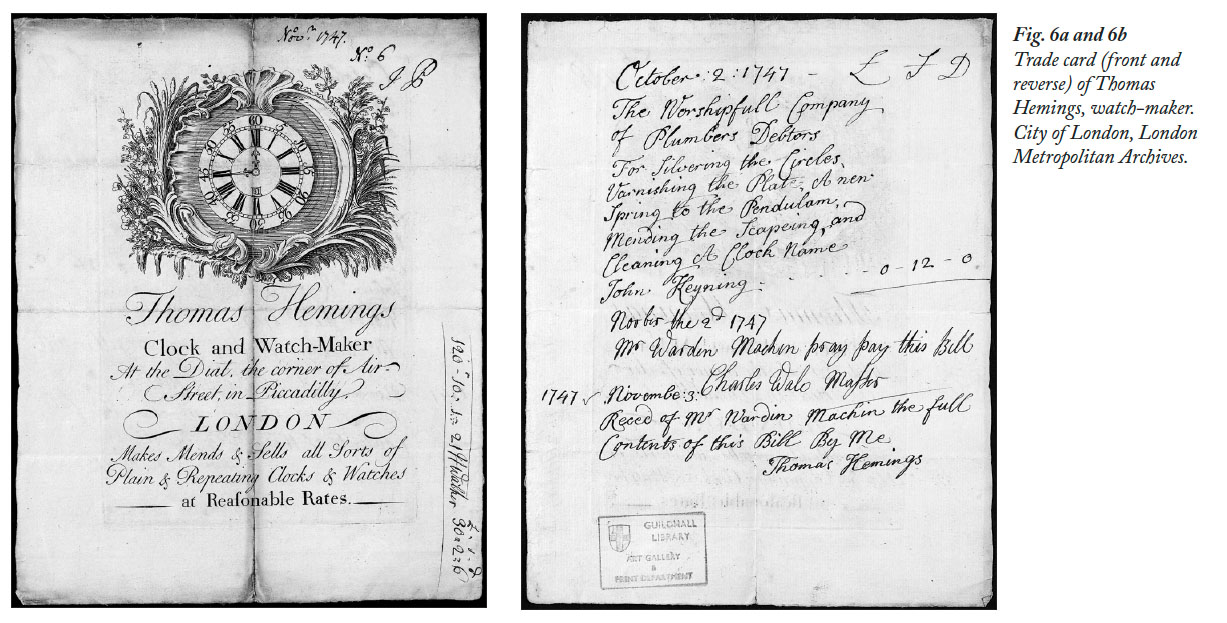 Display large image of Figure 6
Display large image of Figure 632 Trade cards customized as private invoices reflected the greater efficiency in credit organization as part of the increasing professionalization of shopkeeping in the second half of the 18th century. Some tradesmen commissioned trade cards typographically adapted for the specific purpose of writing out a customer’s bill. The card for French bijoutier-quincaillier CharlesRaymond Granchez (ca. 1770) included the addition of a printed area in which to inscribe transactional details (Fig. 7). Similarly, the advertisement for chandler Joseph Palmer of Boston (ca. 1770) incorporated a printed section reserved for recording invoices (MHS, Bdses-Sm 1770). Both the promotional text and the billing information on Palmer’s card were written in English and French, enabling him to efficiently participate in Atlantic commerce.
33 As these tokens of private consumption passed from retailers to customers as bills and then receipts, they became the property of the consumer to be retained and integrated into private accounts as evidence of purchases and household expenditure. Once trade cards became possessions, they could be perused at leisure and annotated or organized as the owner saw fit. Some consumers added their own notes as a mental reminder of the specific contractual arrangements and the settlement of the debt. In April 1740, a year after a purchase had been made, James Grant annotated the back of a trade card he had received from engraver Chris Seton with a note reading: “paid Mr. Seton two pounds twelve and sixpence as due for cutting my crest motto and setting the same” (NAS POF, GD248/102/9/1). Grant signed the bottom of the bill as confirmation of his actions and then filed it among his other household accounts. Where households juggled multiple credit arrangements with numerous suppliers, it was essential that tradesmen communicate billing information efficiently. Customer accounts neatly arranged on highly graphic and tactile trade cards provided a pertinent reminder of particular shopping experiences and the economic responsibilities these engendered.
34 As these bills moved between commercial and domestic spaces, they provided a material reminder of what Craig Muldrew has described as the “reciprocal bonds of trust” formed through credit agreements (1998: 128). As well as performing highly practical functions, trade card invoices mediated relationships, enabling tradesmen to formally raise the delicate issue of debt in a polite manner. This billing procedure formed part of the culture of “polite consumption” and professional sociability, permitting shopkeepers and tradesmen to extend their courtesies beyond the moment of economic exchange and outside of the formal marketplace. Despite the inevitability of debt recovery, obtaining payments from customers was not always easy. Credit agreements were frequently arranged casually and the corresponding invoices could be issued months, if not years, after an initial transaction had been made. Trade card invoices, circulating as courteous commercial notices and luxury prints, were a culturally acceptable way to request payment. They provided a physical reminder of a debt while veiling a base economic agenda in prevailing modes of politeness.
35 Trade card invoices were not merely an inevitable outcome of economic exchanges but deliberately encoded ideas about taste and status and underscored the unique bonds between shopkeepers and their most valued customers. They accrued a gift value as they moved between public and private spaces. The action of retaining handwritten billing information to the reverse of trade cards had the effect of demarcating the space between the graphic element and the transactional information. Finely engraved prints endorsed with personal information became gifts in economic exchanges, perhaps setting in motion obligations and expectations on both sides. Natalie Zemon Davis has examined the role gifts played in early modern transactions, observing that they sometimes performed as contracts for payment and “a pledge of confirmation of an agreement” (2000: 89). Trade cards adapted as personal invoices reinforced the notion of credit to privileged customers, perhaps reminding them of the nuances and inconsistencies of credit selection and of their own elevated status. Furthermore, trade cards exchanged between private individuals as both miniature graphic prints and tokens of exclusivity were reminiscent of those other small engravings—visiting cards and admission tickets—that moved between people and places as symbols of polite sociability. Graphic trade cards circulated within similar economies of exchange as portable markers of relationships within commercial society.
Trade Cards: Circulation and Collecting Economies
36 Many trade cards throughout their lifecycle moved from commercial centres to collecting environments. Within this context, they travelled between public and private spaces as engravings, accruing value as graphic commodities that became part of 18th-century collecting cultures. The interest in trade cards as collectible prints resided in their pervasive graphic content and their close associations with the history of engraving and well-known artists. Trade cards collated for these reasons became part of private collections and were subject to the same patterns of retention as other graphic prints. Examples surviving in these contexts often exhibit the material markings of human interaction, but unlike those which signified private economic exchanges, these markings connected trade cards to the behaviours and practices that defined print collecting.
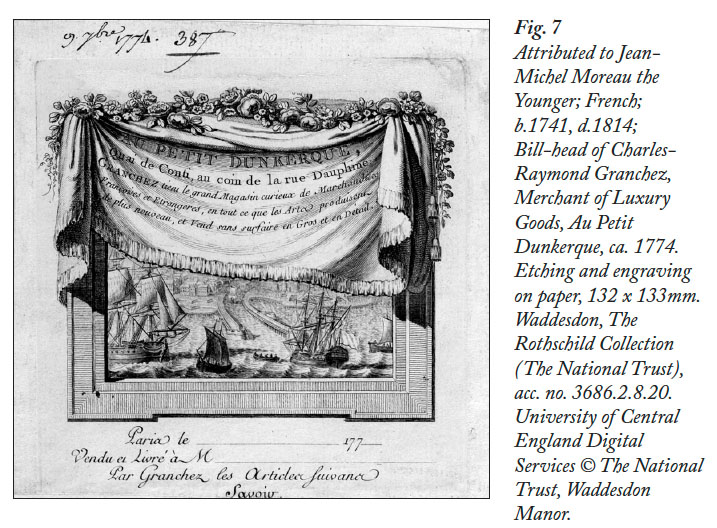 Display large image of Figure 7
Display large image of Figure 737 In England, the earliest collected trade cards in the 17th century were closely associated with the visual cultures of commerce and the street through their stark representations of shop signs and other emblems of trade. Interests in printing history, folk art, street ephemera, and the topography of London motivated trade card collectors John Bagford and Samuel Pepys. Pepys’s forty-one cards formed part of a larger collection of prints related to the cities of London and Westminster.9 In the 18th century, print collecting grew in popularity as a market for cheaper prints emerged. Printsellers’ catalogues, auction guides, newspaper advertisements, and trade cards testify to the proliferation of more affordable graphic genres at this time. The trade card for English printseller Elizabeth Griffin (ca. 1749), produced in the style of a medley print, conveys the rich graphic world in which trade cards circulated by the mid-18th century (Fig. 8). The illustrated advertisement incorporated multiple overlapping images including a plate from Matthias Lock’s pattern book A Book of Ornaments, watch papers, maps, drawing studies, satirical images, and a centrally located trade card. The total image characterized the dynamism of the graphic art world of the period while highlighting the range and diversity of the prints circulating within what Mark Hallett has described as a “crowded urban nexus of graphic commodities” (1999: 38).
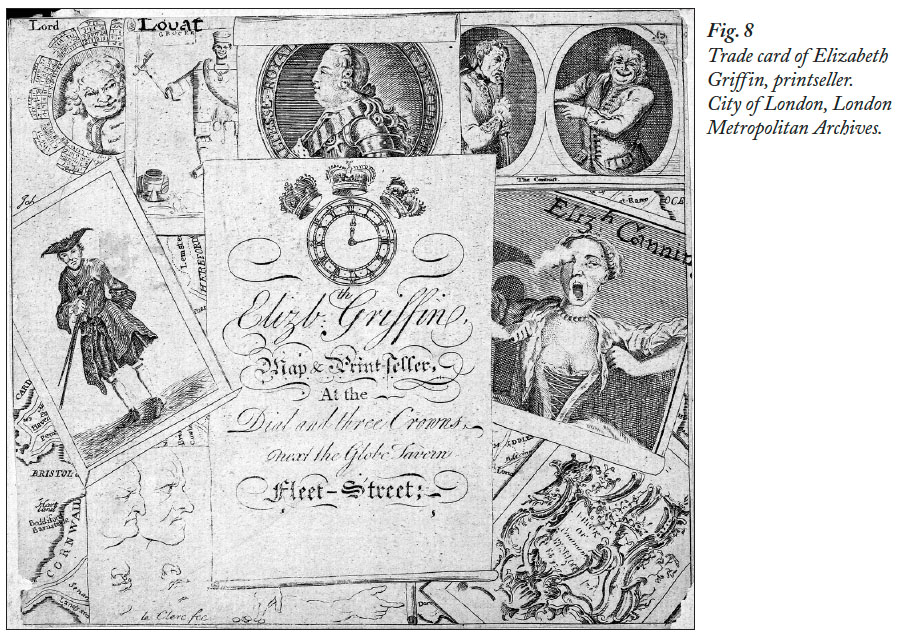 Display large image of Figure 8
Display large image of Figure 838 Trade cards acquired the status of miniature artworks with close connections to well-known engravers and other visual genres. They were produced in the same workshops as other prints and shared a graphic vocabulary with multiple print genres that formed part of a rich visual culture. In England, engravers such as Matthew Darly, Benjamin Cole, George Bickham, Butler Clowes, William Austin, and Henry Copland produced a wide variety of single-sheet prints such as invitation tickets, music sheets, certificates, and trade cards as well as plates for technical manuals, pattern books, illustrated dictionaries, journals, and magazines. These engravers worked with a graphic vocabulary of iconographical emblems and images which, when applied to these multiple graphic products, produced a pervasive visual uniformity across diverse print genres.
39 This visual cross-referencing between trade cards and other printed images elevated their status from illustrated advertisements to graphic prints. Trade cards invited viewers to explore complex imagery, decode allegorical messages or tease out visual connections with other images.Some trade card engravers deliberately referenced other well-known images or the work of established artists. For example, the sociocultural issues concerning “industry” and “indolence,” explored by William Hogarth in his series of prints Industry and Idleness (1747) and by George Bickham in The Universal Penman (1741), provided the visual themes for William Clark’s trade card for trunk-maker Samuel Forsaith (ca. 1760; Fig. 9). In this card, Clark, the engraver of some of the plates for Bickham’s Penman, included pictorial narratives in cartouches labelled “Industry” and “Indolence.” For the informed spectator, these allusive images not only signified Forsaith’s shop sign but were also related to contemporary issues explored in other famous prints and texts. The card for chemist Richard Siddall, engraved by Robert Clee in the 1760s, directly referenced a series of paintings by French painter Jacques de Lajoue made for the Duc de Picquigny in 1735 and later engraved by Charles-Nicolas Cochin (Fig. 10). Maxine Berg and Helen Clifford suggest that, for collectors, the joy of Siddall’s card came from recognizing its original source (2007: 163). In the auction catalogue for the sale of J. E. Hodgkin’s ephemera collection in 1914, Siddall’s card was advertised as “cut to shape and mounted” (GL, Sotherby, Wilkinson & Hodge 1914: 3). As this trade card moved from a commercial setting to a collecting environment, it functioned as a graphic print for framing and displaying in domestic interiors or mounting alongside notable other prints in a portfolio.
40 By the second half of the 18th century, trade cards were closely associated with a country’s artistic heritage. In Britain, they were collected and traded as artistic souvenirs of an engraver’s work. Both jobbing engravers and established artists produced trade cards. In the 1720s, Hogarth engraved several at the beginning of his career, while Francesco Bartolozzi engraved his as an established and popular society artist towards the end of the century. Avid print collectors Joseph Gulston and Sarah Sophia Banks, both of whom compiled large and wide-ranging print collections, were interested in trade cards as a graphic genre linked to the wider culture of print and famous engravers. In 1786 and 1791, Gulston’s vast print collection containing, along with trade cards, thousands of foreign and English portraits, caricatures, and topographical views, was sold at auction. It is likely that Banks acquired trade cards from Gulston’s sale. On the reverse of her card for Matthew Darly’s paperhanging manufactory, Banks noted that she had acquired it in 1791, the year of Gulston’s final sale (O’Connell 2003: 173-74). Horace Walpole had attended Gulston’s print sale in 1786, remarking in his copy of the auction catalogue that the “most extravagant and ridiculous prices were given for some prints, especially for the most rare and worst of Hogarth’s” (HL, Greenwood 1786). Among these were several of Hogarth’s early trade cards. One, described as “a shop bill, by Hogarth with emblems of Trade, the Duke of Tuscany’s arms at top, &c. very rare” fetched a price of “£6-6-0,”10 a figure underlined by Walpole to emphasize the enormity of the sum (147). Two other cards by Hogarth, “his card, and the Angel shop bill, very scarce,” sold for £11-15-011 (112). While these trade cards were perhaps rather crude examples of Hogarth’s work, the diminutive prints were nonetheless rare examples of the artist’s earliest engravings. Walpole also remarked upon the work of Bartolozzi that had “sold very dear.” Among the various portraits attributed to Bartolozzi were tickets to a “Masqued ball, at the Opera House and cards,” described as “scarce and fine” (39), and a further set of visiting cards “eight by Bartolozzi, Mrs. Parker’s card, Sir Joshua’s card, &c” (3). While Hogarth’s trade cards were posthumously celebrated, the small items amongst Bartolozzi’s more prestigious pieces were sought-after as “scarce” and “fine” examples of the work of a famous and contemporary engraver. Sarah Banks was a particularly enthusiastic collector of prints by Bartolozzi, organizing his visiting cards and admission tickets separately from her other collections. Within the context of print collecting, trade cards and other small ephemeral prints were not retained as fragments of everyday life but as valuable images and miniature tokens of an artist’s work that commanded their own commodity value.
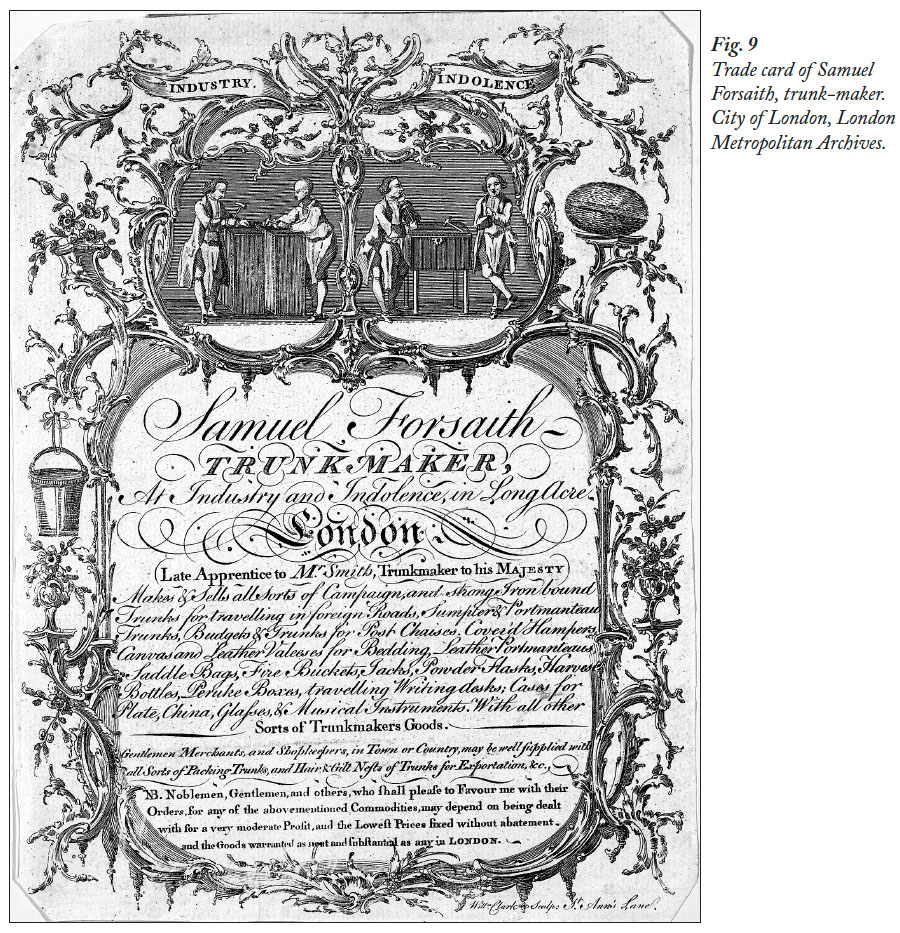 Display large image of Figure 9
Display large image of Figure 941 The collecting activities of Gulston and Banks suggest that networks of collectors, friends, and acquaintances exchanged information and examples. Banks was especially well connected through her brother Joseph who granted her access to contacts such as members of the Royal Society and the Society of Antiquaries. Joseph also maintained direct contact with many London engravers who produced the types of ephemeral prints in Sarah’s collection (Pincott 2004: 14). In a letter to Sarah Banks in 1791, John Charles Brooke enclosed an admission ticket to the royal fireworks in 1749 with an accompanying note offering her “a dinner ticket for Painter’s Hall in 1689, with different devices engrav’d ... if she has not already got one” (O’Connell 2003: 224). Similarly, Lieutenant-General William Thornton wrote to Banks informing her that on having heard that “she [wa]s making a collection of cards and engravings, [he] t[ook] the liberty of enclosing some which appear[ed] to him to be well executed by Mr. Woodthorpe of Fetter Lane” (Pincott 2004: 14). Trade cards and other significant engravings moved between Banks’s various contacts before being assimilated into her print collections.
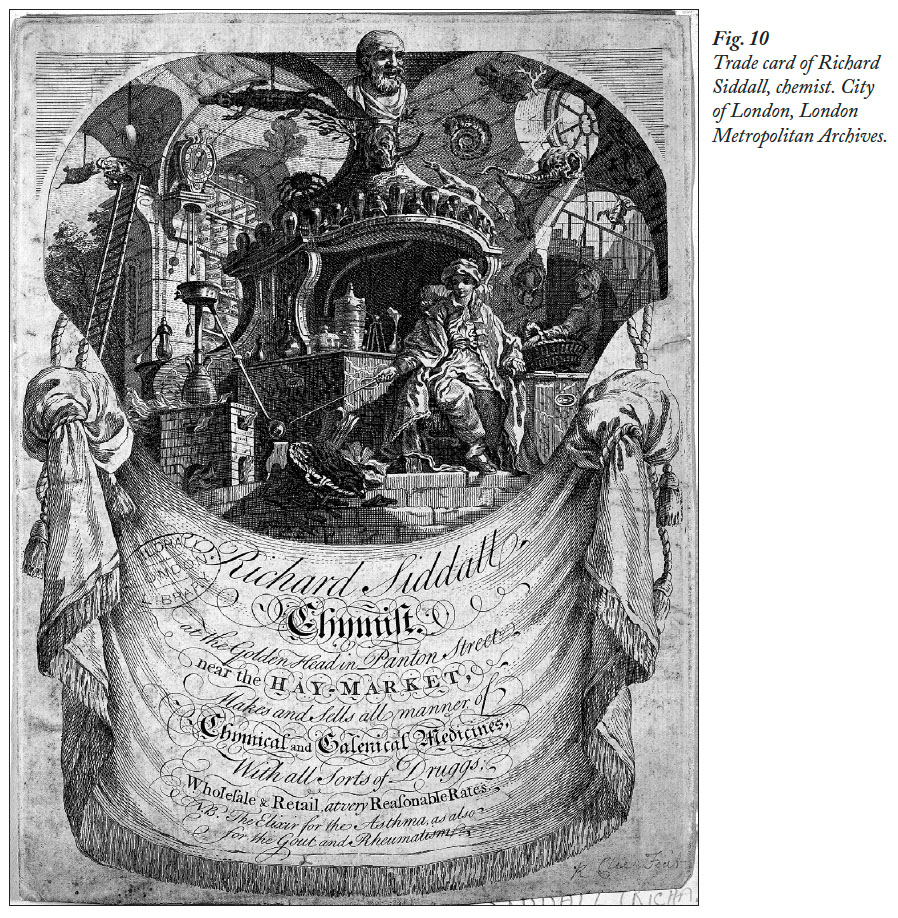 Display large image of Figure 10
Display large image of Figure 1042 The trade cards in Banks’s collection moved between networks of engravers, collectors, and other well-placed contacts. Examples of foreign trade cards in her collection suggest that they also moved between countries. The European (mainly French) trade cards in Banks’s collection convey her more general interest in the genre and rare examples from other countries. In the collection of trade cards at Waddesdon Manor (U.K.), accumulated some time after the period examined here, the largely French collection is augmented with examples from Germany, Austria, Italy, and Switzerland. In the fourth and final portfolio of this collection, the many examples from the Hapsburg Empire may have come via the parents of Ferdinand de Rothschild (the owner of the collection from 1891) residing in Vienna at the time (Plock 2008: 23). In the collecting circles that coalesced around these well-connected collectors, trade cards and other graphic ephemera not only passed between multiple hands but also moved across geographic spaces.
43 Trade cards accumulated as graphic collectibles were occasionally subject to the same modes of visual interrogation and collecting behaviours devoted to other print genres. English antiquary and print collector Francis Douce annotated his prints with supplementary information, conveying the breadth of his interest and his knowledge of wider graphic culture. On the back of his trade card for London stationer and printseller Dorothy Mercier, Douce included his observation that the card was a “very rare and curious print” (Lambert 2001: 70). As well as providing additional information on Mercier, Douce also noted that the trade card was designed by Frenchborn engraver Hubert Gravelot and etched by Jean Baptiste Claude Chatelain (2001: 70). This supplementary information was not contained within the body of the print, suggesting that Douce had researched the details of Mercier’s business and the attribution of the image. The trade cards in Douce’s collection accrued capital as both entertaining objects and prints of cultural significance.
44 Trade cards collected as graphic prints were not only subject to critical comment and organization but were also occasionally clipped of the extraneous remnants related to their former commercial purposes. In collections of trade cards that have been collated as small graphic artworks, examples exist where the billing information has been concealed or removed entirely. Trade cards in the collection at Waddesdon Manor have been stuck down to the pages of print portfolios, thereby prohibiting a full examination of any additional markings made on the reverse of the images. Conversely, several engraved billheads retained in the household accounts for the Boulton family in Birmingham, England contain only the billing information and reveal a blank space signifying the omission of the graphic content, perhaps removed to form valuable additions to a scrapbook or print portfolio.12 As these illustrated advertisements moved between commercial and collecting environments, they could be stripped of the elements that identified them as trade-related prints and appropriated into print collections as miniature artworks.
45 The active accumulation of trade cards as collectible engravings in the 18th century conveys their cultural promiscuity as portable objects that moved between, and were reconfigured within, varied cultural and discursive territories. Some also moved between different scales of collection, from small-scale private assemblages to large, expanding collections, some of which assumed public importance as part of museum print collections.13 Trade cards surviving within this cultural context made the greatest shift from a mode of commercial advertising to objets d’art and tokens of national significance.
Conclusion
46 In the 18th century, trade cards moved between public commercial centres and private domestic spaces as mobile advertisements, personalized bills, and miniature artworks. The varying contexts in which they survive in collections today convey their transformative nature. The material markings on many trade cards also reveal aspects of their exchange, retention, and re-appropriation as they traversed public and private spaces and were assimilated into domestic environments as practical commercial sources, private mementos, or print collectibles. The meanings encoded within trade cards were mutable as they passed through time and space. By studying the movement, circulation, and exchange of trade cards we can uncover the central role they played in shaping the processes, habits, and behaviours of consumption and collecting in the 18th century. By highlighting the longevity of trade cards in social life, we complicate the traditional categorization of trade cards as “ephemera.” In the 18th century, these unique graphic advertisements were not the throwaway fragments of promotional cultures but valued tokens of private economic relationships and rarefied objects.